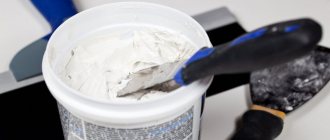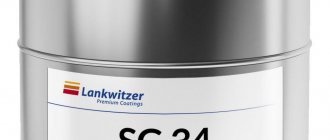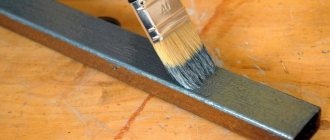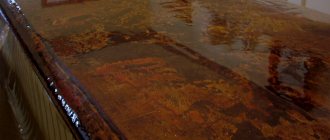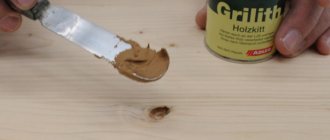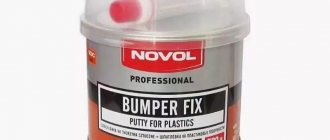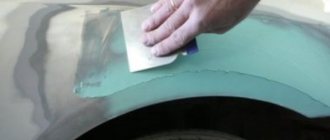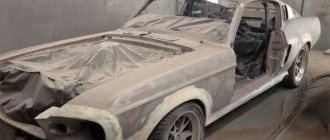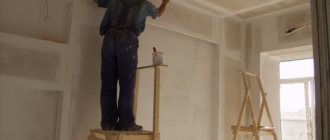Epoxy putty: application , consumption
At the moment, the modern building materials market is represented by a huge variety of mixtures that have different purposes and principles of application.
Among the incredibly large range of building materials offered, you should pay attention to epoxy putty, which is used for finishing work.
Using this mixture, you can reliably seal small cracks, scratches, sinkholes, and also level surfaces made of different materials.
Features of the material
After drying, the mixture forms a hard layer, which, depending on the shape, retains its geometry. In addition, epoxy putty has a lot of positive qualities, including:
- versatility;
- excellent base for applying paint;
- elimination of surface defects;
- no odor;
- durability while maintaining an aesthetic appearance;
- resistance to mechanical stress;
- low price.
Depending on the composition, the putty can be waterproof, chemically resistant, does not shrink and retains its properties for quite a long time.
Details
Characteristics
Epoxy puttying compounds have gained vocation and incredible popularity in modern construction due to such a number of inherent positive characteristics:
- There is no aroma.
- Moisture resistant.
- The coating is very durable.
- Minimum shrinkage values.
- Resistant to aggressive liquids.
- Easy to sand.
- Durable in use.
Due to the slow hardening of the solution, it will be possible to thoroughly mix its components until a homogeneous consistency is obtained. Another advantage of epoxy puttying material will be the quality of application, which allows you to proceed with further finishing of the surface without using additional priming. To preserve the main qualities of the mixture, substances such as solvents should not be used. Epoxy compounds are known not only for their high level of resistance to mechanical stress and the destructive effects of chemical composition, but also for their ability to resist the formation of mold and mildew. All the qualities that are listed explain the popularity of using the composition in question for performing not just internal, but also external construction work.
Kinds
When choosing an epoxy putty, you need to pay attention to its labeling, which will determine the main qualities of the composition. The most popular materials have become EP-0010 and EP-0020. Each of the compositions that are listed, due to special parameters, is used to solve certain problems and has certain recommendations regarding the rules of application.
EP-0010
Epoxy compounds with this marking are used mostly for leveling the surface of products made from various materials. On sale, as is correct, it can be found in the form of a paste-like thick composition, which is brought to a liquid state by mixing with diethylenetriamine or hardener No. 1. When the EP-0010 putty is brought to a solution with a uniform consistency, it can be used as a primer layer before painting. The main parameters of two-component epoxy putty make it possible to use it both indoors and outdoors. Apply the composition to primed surfaces of products, and to those that are not treated. The average time for complete polymerization of the primer composition at an ambient temperature of +18...+23 degrees is approximately a day, and when the temperature rises to +65 degrees, about 7 hours.
The composition in question can be applied to almost all types of surfaces. It should be noted that the epoxy composition EP-0010 has fairly high elasticity, but when it dries 100%, it forms a smooth and durable layer with a red-brown color. Sanding treated with putty, which is marked EP-0010, needs to be done only using the wet method, which involves adding water.
EP-0020
Epoxy compositions marked EP-0020 have a finely dispersed filler structure, which will ensure economical consumption of the composition for processing products with a certain area. But it should be noted that such compositions are used primarily as a finishing coating and are not suitable for application with a thick layer to correct noticeable defects and irregularities.
Main components
Epoxy resin putty is a two-component material containing:
- epoxy resin;
- filler (metal powder or fiberglass shavings);
- hardener.
The two components are sold as a set, but in separate containers, since the ingredients must be mixed immediately before use. The composition must be stirred thoroughly, making sure that both components are evenly distributed throughout the volume of the solution. It is also worth remembering that polymerization of epoxy resin occurs within 8 hours.
Types of putty by purpose
Based on the nature of the filler, wood, concrete, plastic and metal can be treated with epoxy putty. Using the mixture will help partially restore and strengthen the structure of the base coating.
For wooden surfaces
Epoxy wood putty does not shrink after drying. This ensures the elasticity of the material, which is quite important when working with wood. The resulting coating lends itself well to sanding and processing, after which it can be painted in the desired color.
Epoxy wood putty is used in the following cases:
- if necessary, repair cracks, potholes, scratches;
- floor repair work when sealing joints and cracks;
- waterproofing works;
- processing of doors, windows and wooden furniture.
When performing exterior painting work, you should choose epoxy mixtures. The putty is characterized by a two-component composition based on petroleum resin, pigment substances and organic solvents. Speaking of disadvantages, epoxy wood putty is not covered with stain. Therefore, if you plan to impregnate wood with this composition, it is better to discard the material.
This composition is resistant to deformation, perfectly fills surface defects, is moisture-resistant, wear-resistant and durable.
For metal
Having excellent adhesion, the epoxy composition is suitable for leveling metal surfaces. It is preferable to use a mixture with a filler of the smallest metallized particles that the surface to be putty contains.
This putty is widely used by motorists, as it reliably protects metal (in particular the car body) from corrosive processes and rust.
For plastic
Epoxy-based putty is characterized by high adhesion and elasticity, so it can be used to restore PVC pipes or when repairing car bumpers. The material is used in the following industries:
- construction;
- shipbuilding, aircraft manufacturing and mechanical engineering;
- construction of bridges;
- construction of pipelines and various metal structures;
- tanks and hydraulic installations.
Using epoxy resin will help fill in bumps and other defects on the car body. Among the disadvantages, high toxicity is noted, so all work should be carried out in a respirator and protective mask.
For concrete base
Epoxy putty for concrete is made with the addition of cement and coarse sand, which significantly increases the adhesion of the base to subsequent finishing. Impregnation with this composition makes the surface rougher, after which it is ready for plastering.
When sealing cracks in concrete, regular epoxy glue is often used to fill the crack and then level the surface.
In the video: Sea-Line universal epoxy-based putty.
Gypsum mixtures
Eco Finish gypsum finishing putty
Gypsum-based putty mixtures are the least popular option for leveling the surface of concrete floors. The advantages of this material include:
- no shrinkage;
- low cost.
The gypsum composition creates a perfectly smooth surface from the first layer, dries quickly and can be colored with any color (as a more budget-friendly option, you can use artistic gouache), however, it has one significant drawback - the material is not suitable for rooms with high humidity.
Price for gypsum putty
Making your own putty
You can make epoxy putty yourself. To do this, you need to purchase epoxy resin and hardener, as well as fillers, depending on the type of surface to be puttied. For preparation you will need:
- for composition on a wooden base - fine sawdust, chalk or gypsum;
- when working on metal – metallized particles, usually aluminum powder;
- when used on plastic - fiberglass and colored pigment, which will help make the putty area invisible;
- for concrete pavement work - cement, sand or fiberglass.
Making the composition is quite simple, but maintaining the proportions is important. The amount of hardener should not exceed 3% of the total volume of the mixture.
Application of the composition
Epoxy putty is suitable for filling small cracks and scratches.
This product, as well as other putty mixtures, is used in repairs and construction:
- for leveling floors, walls and other surfaces made of concrete, stone and wood;
- for waterproofing;
- in order to adhere building materials to each other (for example, plastic, wood, metal, ceramic products, etc.);
- for sealing seams, mechanical damage, etc.
Return to contents
General characteristics
The presented building material hardens slowly, so the solutions can be mixed slowly to obtain the desired consistency. The polymerization process begins an hour after application to the surface. The mixture hardens after 6 hours. Then you need to wait a few more hours and only then start sanding and finishing.
An undoubted advantage is that after applying epoxy resin, the products do not need to be primed, but can immediately proceed to painting. To do this, it is enough to clean the surface from dirt and dust, and if necessary, degrease it.
Application of material
Epoxy-based putty can be used for both interior and exterior decoration, so the composition is highly frost-resistant. The mixture provides reliable protection of the surface from fungus and mold. The coating can be matte or semi-matte.
To obtain a high-quality surface, you need to apply putty in 2 layers. The drying interval for each layer is 24 hours. Application work must be carried out at a temperature not lower than +5°C.
Using epoxy putty (2 videos)
Various epoxy putties (22 photos)
Well-known manufacturing companies
A substance with these characteristics is produced by Ceresit.
The sales market offers a large number of non-toxic, solvent-free products for treating concrete surfaces. The most famous are SK Palmyra, Politax, Epital, Elakor, Ceresit, Knauf, which comply with technical regulations on fire safety, sanitary-epidemiological and hygienic requirements for the installation of polymer coatings. Putty in ready-made form and freely available can be purchased at a construction supply store, however, it is worth considering that its price is high, but it is compatible with almost all epoxy and polyurethane materials produced by us and from foreign manufacturers.

